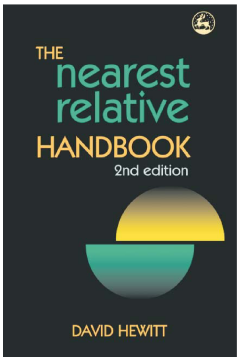
Additional Information
Book Details
Abstract
When a person is subject to the Mental Health Act, many of his or her principal rights are taken away. It is the function of the nearest relative to compensate for that loss.
This fully updated second edition explains how the nearest relative is identified, and how in some cases he or she might be displaced. It also contains a wealth of new case examples and illustrative scenarios, providing a succinct discussion of each significant case and incorporating all the very latest changes to the Mental Health Act.
The Nearest Relative Handbook will be an invaluable aid to those who find themselves in a professional relationship with a nearest relative, to those who are or wish to be a nearest relative and to anyone needing to make sense of the relevant statutory provisions.
David Hewitt is a solicitor and a partner in Weightmans LLP. He was a member of the Mental Health Act Commission for nine years and now holds visiting fellowships at Northumbria University and Lincoln University. He is a President of Mental Health Review Tribunals and sits on the editorial board of The Journal of Mental Health Law. He appeared as a witness before the joint Parliamentary committee on the draft Mental Health Bill of 2004.
This intelligent and comprehensive analysis is a welcome addition to the currently scant literature in this area.
Journal of Mental Health Law
An excellent reference book that could be used by all members of integrated community mental health teams in England and Wales.
Simon Stockwell, Practice: Social Work in Action
There can hardly be a professional concerned with MeHA 1983 and its practical application in daily practice who will not benefit from having this book to hand...
New Law Journal
Praise for the first edition:
'An excellent, comprehensive and thoughtful guide to the rights, powers, and duties of nearest relatives under the Mental Health Act. This is the definitive work on the subject.'
Phil Fennell, Professor of Law, Cardiff Law School
Hewitt looks first at the development of the role of nearest relative, where it is now, the problems it presents and how these are likely to be resolved…The rules are comprehensively worked through and the examples clear.
Tony Eaton, Solicitor, Brent Community Law Centre
Table of Contents
| Section Title | Page | Action | Price |
|---|---|---|---|
| Editorial | |||
| Caroline Sweetman | |||
| Avoice of alarm: a historian's view of the family | |||
| Anna Arroba | |||
| Patriarchy and development in the Arab world | |||
| Suad Joseph | |||
| Fighting female infanticide by working with midwives: an Indian case study | |||
| Ranjani K Murthy | |||
| Female-headed families; a comparative perspective of the Caribbean and the developed world | |||
| Shelia Stuart | |||
| Structures and processes: land, families, and gender relations | |||
| susie Jacobs | |||
| Women, the law, and the family in Tunisia | |||
| Hafidha Chekir | |||
| Marginalisation and gay families in Latin America and the Caribbean | |||
| Dinnys Luciano Ferdinand | |||
| Child-care and the benefits trap: a case from the UK | |||
| Annie Oliver | |||
| Interview: Maria Isabal Plata of PROFAMILIA | |||
| Resources | |||
| Book review: Kampala Women Getting By: Well-Being in the Time of AIDS by Sandra Wallman et al | |||
| Ambreena S Manji | |||
| Further reading | |||
| NGOs and UN organisations | |||
| Audio-visual resources. |
